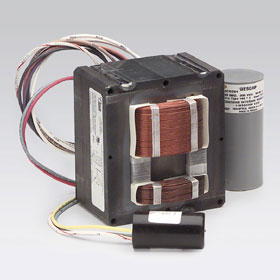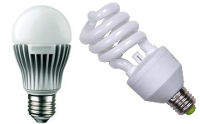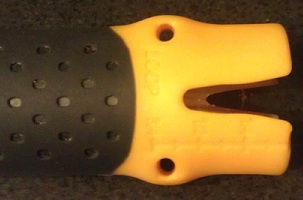Archive for February, 2012
Tool Review: Ideal Lil’ Ripper Stripper™
I recently picked up the Lil’ Ripper Stripper™ from Ideal Industries, at Home Depot for about $5.00.
Not that I needed a new tool, especially another wire stripper; but for $5.00, how could I resist?
Really, I was just interested to see how useful it actually was. I’m almost always skeptical of multi-tools, since they aim to replace tools designed specifically for a single task. The Lil’ Ripper Stripper is no exception, so it really has to preform well to replace tools in my tool pouch.
Features:
- Rips Romex® wire outer jacket cleanly and quickly.
- Clips outer sheathing to remove excess Romex® wire jacket.
- Strips inner conduit wires.
- Looping holes loop wire for screw-on connections.
- Twist-Assist™ tightens most popular sizes of winged twist-on wire connectors.
- Injection molded elastomer grip provides a comfortable, slip resistant grip.
- Strip length measuring scale allows for quick and easy measurements.
- Conveniently fits in your pocket.
Since Ideal gave me a good feature list, lets tackle each one individually.
Ripping Romex® (NM wire)
The Lil’ Ripper Stripper, makes ripping non-metallic cable sheath simple and fast. If you look in one end of the tool, you’ll notice a small metal hook.
To rip the cable, simply place the hook under the cable sheathing, then slide the tool along the cable. The Lil’ Ripper Stripper definitely earns this part of its name, this thing rips cable like a champ. It slices through the sheath clean, fast, and without any concern of nicking the conductors. Because of its shape and size, you can even easily rip the sheath from cables already installed in boxes.
Removing excess sheathing
To remove the excess sheathing, you slide the sheathing into the large notch, at the end of the tool, and pull.

This feature seemed like an afterthought, or maybe the cutting blade was relocated to accommodate another feature. Either way, it’s not great at this. The cutting blade is set back a bit too far, which makes getting the excess sheath deep enough to cut it a challenge. Even the guy in the demo video had trouble with this feature, so it doesn’t seem to be user error on my part.
Stripping conductors
To strip the conductors, you simply slide the wire into the V notch at the end of the tool, give it a couple twists, then pull the insulation off.
It works relatively well, though it can easily nick the conductors if the wire is inserted too forcefully. You’ll also notice a measuring scale on the face of the tool, which helps you determine how much insulation to remove.
Terminal loops
To create terminal loops in the wire, you insert the wire into one of two holes on the side of the tool, then give it a quarter turn.
This is a nice feature, and works very well.
Twist-Assist™
To twist on wire caps, insert the cap into the end of the tool, insert the wires into the cap, then twist. This is a handy feature if you’re working in gloves, and find it difficult to twist on little wire caps because of it. The length and size of the tool give you a little extra grip, allowing you to twist on the wire caps without a problem. It’s only designed to work with winged wire caps, so if you’re working with caps without wings, you’re out of luck.
Comfortable, slip resistant grip.
The tool is comfortable in your hand, and it does provide a slip resistant coating. However, the best part of the grip is the constant reminder that you shouldn’t be working on live circuits.
Conveniently fits in your pocket
Yes, it does fit in your pocket. But guess what Ideal… I want it to hang from my tool belt! Is it too much to ask for a key chain loop, so I can hang it from a carabiner on my tool pouch? I guess then they’d have to charge $5.50 for the tool, and maybe that’s too steep for the average DIYer.
All in all, this is a fairly nice tool. It would be a nice addition to any DIYers tool belt, er… pocket. It rips cable sheath really well, strips wires, makes terminal loops, and helps twist on wire caps. It’s a useful, sturdy tool, but I’m not sure I’m ready to give up my wire strippers just yet. For a DIYer looking for a useful inexpensive tool, this is a good solid choice. The Idea Lil’ Ripper Stripper gets 3.5 Captain Constructions, out of 5.
Fluorescents and Legislation, Part II
The death of the Plain Jane fluorescent tube is in the cards. Lighting legislation signed into law in 2007 has been coming at us for 5 years. Fuel economy for vehicles, bio-fuels, lighting fixtures, lamps, appliances and building energy savings were all targeted, along with other items too numerous and way over my head. In 2010, manufacturers were no longer able to manufacture magnetic ballast. These were the coil and core ballast that weighed a ton.

When suppliers started to run out, your only choice was electronic ballast. You know, if you’re old like me you can remember when those ballasts stuck their heads out in the 70’s, and after all the smoke from lawsuits and finger pointing cleared, they hid their ugly heads for 25 years. In 1995, when you took your 40 watt ballast to the hardware store, it had to replaced by a 34 watt. Now when you take your 34 watt ballast in, you get this little lightweight thing to put in your fixture. “How can I be getting my money’s worth? This thing is too light!”
In 2010, if you had to change your fluorescent fixture, you had to start using those skinny tubes. “Light-weight fixtures and skinny tubes,don’t take me for a fool!” Starting July 14, 2012, the manufacturers will stop making all the old fashioned T12 lamps. With a few exceptions, when you take that 8 foot tube in your garage to get it replaced, or that wimpy 34 watt 4 foot tube in to get a replacement, not only will you have to buy a new fixture, you will also have to take the evil old lamps back with you, because they are now hazardous waste. “These kids now-a-days don’t know nuttin!”
If you are one of the few that read the “Energy Independence and Security Act of 2007” you might make heads or tails of it. If you understood it, then English must be a second language. But the good news is: it’s working for the most part. It is costing us an arm and leg, but it’s working. Now when you and I have the simple job of changing light bulbs, it becomes a major DIY project. It is costing us. Now what do we get out of it? More power. Since it has security in the title, do we get to carry a gun? Heck No!
Out of all the energy used in the US, 25% is used in homes and 19% is used in commercial buildings. It was estimated that energy use would spike 44% from 2005 to 2030. Seven years later it looks like that spike will only be 14%. If you do your math like our politicians, we will save 68%. But it’s 68% of nothing, and this time nothing is a good thing. You can look at it and say we saved 68%, or you can look at it and say we created 68%. It’s not from some new wind, sun, aluminum foil technology, it is a new technology. A technology called “Renewable Energy”.
Now, when you do your honey-dos, whether it’s caulking, insulating, installing blinds, or sitting under the shade of a tree you planted years ago, you know that you are pioneering new grounds.
On the numbers I used, I didn’t just grab the first numbers I found, I did try to check their sources. Probably the best source is EIA Annual Energy Outlook 2008.
Light Bulbs and Legislation
 I’ve been in the electrical wholesale business for almost 30 years and every day I sell light bulbs. For over 30 years lamps basically got better, offering more light output per watt on the newer lamps. But recently somebody started taking my light bulbs away. What am I going to do? What are all the old people going to use to read their papers?
I’ve been in the electrical wholesale business for almost 30 years and every day I sell light bulbs. For over 30 years lamps basically got better, offering more light output per watt on the newer lamps. But recently somebody started taking my light bulbs away. What am I going to do? What are all the old people going to use to read their papers?
Younger people tend to understand this, while other people tend to get upset that the government is getting involved in something as simple as light bulbs. Most people don’t even know it’s happening. So now I let out the secret.
GENERAL SERVICE INCANDESCENT LAMPS
|
Rated Lumen Ranges |
Maximum Rate Wattage |
Minimum Rate Lifetime |
Effective Date |
| 1490-2600 | 72 | 1,000 hrs | 1/1/2012 |
| 1050-1489 | 53 | 1,000 hrs | 1/1/2013 |
| 750-1049 | 43 | 1,000 hrs | 1/1/2014 |
| 310-749 | 29 | 1,000 hrs | 1/1/2014 |
What does this mean? On January 1st 2012, 100 watt light bulbs went bye bye. Well not really. On January 1st 2012 light bulb manufacturers could no longer make 100 watt A style lamps (table lamps) for sale in the US. Then on January 1st 2013, 75 watt A style lamps are no longer made. January 1st 2014, 60 and 40 watt go the same way. All these lamps are available until stock is depleted.
Now, why are they doing this? After reading and reading and talking to factory reps and some energy specialists, it has to do with building power plants. The more wattage and kilo-watts saved, the less power used. DUH. If energy is saved on a large scale, then enough energy would be saved to avoid building a power plant. In this age of “not in my backyard”, the legal fees would probably be as high as the cost of building the plant.
Once all the incandescent bulbs are gone, you’ll have to choose between LED and CFL.
Which to use, LED or CFL
Which is better, Compact Fluorescents (CFLs) or LEDs? I’m not the greenest person in the world and normally don’t go out of my way to be green, other than recycling trash.
Compact fluorescent
At one time legislation was going to cost you big time bucks if fluorescents, including CFLs, were broken. It was considered a “hazardous spill” and you had to open your windows; if you cleaned it up yourself you would not be able to use a vacuum or broom, only a sticky tape to clean it up. A professional team did this for a woman in Maine and after everything was done it cost her $3000.00 and insurance did not cover it. Now, it’s still not a good idea to use a vacuum because of the mercury.
Now all fluorescents are required to be recycled. Smaller recycle boxes can cost you as much as $1.50 a lamp to dispose. Some waste companies offer to be open on certain days and be available for you to bring the lamps to them. Today, with this legislation, nobody ever throws their light bulbs away (wink wink).
Light-emitting diode
LEDs are not cheap, but they are coming down in price. Right now the biggest change in LEDs is the lumens per watt, or the amount of light coming out divided by the wattage used. While the wattage on some lamps has not gone up, the light output has. It was just 2 years ago when the LED manufacturers started making lamps equal to a 75R30 (65BR30), which is the most popular residential light at the moment. Prices are starting to come down on older technology LEDs, and more and more stores are stocking them. LEDs contain no mercury, making them easy to dispose of, and no special handling, other than throwing them in the recycle bin. The energy saving is ridiculous! I just changed out 7 – 50 watt MR16 lamps with 7 – 6.2 watt dimmable lamps. That right there is a 87% energy savings, and it cuts out going up and down a ladder 56 times to change the lamps (7 lamps, 8 times). In this case, CFLs were not an option.
Now the negative about LEDs. When they first started becoming a reality in residential lighting they were advertised at 50,000 hours lamp life. Lawsuits happened, causing the big names in LEDs to start advertising 25,000 to 30,000 hours, with some lamps still rated at 50,000 hours. LEDs lose lumens over time, just like incandescent and CFLs, but LEDs lose more than 3 times that of a CFL: 29% to 9%.













